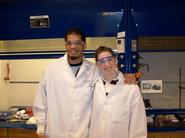
When Maximilien Yelbi ’11 visited the West African Ivory Coast at the age of 12, he contracted malaria. Like many inhabitants of underdeveloped countries, Yelbi suffered from the exhausting grip of the disease, which is the fourth leading cause of death in the world among children under five years old. Its victims live primarily in tropical or sub-tropical countries, where the climate and economic conditions allow for easy transmission and high mortality rates. The sickness eventually left his body, but the thought of it continued to amble through his mind.
“I was frustrated with the futility of people dying when all it took for recovery was a pill,” he said. But natives of sub-Saharan Africa have very little access to medicine. With research partner Rachel Rothbarth ’12, Yelbi is spending the summer studying organic porphyrin compounds. Assistant Professor of Chemistry Nicole Snyder will assist them in their research and help them attach sugars to the porphyrin, forming a carbohydrate-conjugated porphyrin. These molecules have been rumored to serve as photosensitizers in photodynamic therapy as well as inhibitors used in the treatment of malaria. A photosensitizer is a chemical that makes the protein more reactive to photons. It is the students’ hope that their work will lessen the chances of fatality among malaria and cancer patients.
Glucose and galactose, two forms of sugar, may be able to aid in photodynamic therapy, a treatment that uses a photosensitizer to focus radiation. Rothbarth will attach these sugars to porphyrin. What is important about this process is that the sugars will increase water solubility of the porphyrin in attempt to make the drugs more bioavailable, or ready to be used in the body. Once the sugar is connected to the porphyrin, it seeks to bind with malignant tissue. Once radiated with light, the photosensitizer is activated, creating a form of oxygen that eventually destroys the cell.
Yelbi is responsible for attaching two other sugars to porphyrin, xylose and mannose. They will prevent the parasite’s formation of hemozoin (a toxic byproduct) from heme, an iron-conjugated version of their original porphyrin that is found in red blood cells. Hemozoin is critical in keeping a parasite alive, so Yelbi needs to bind the conjugated porphyrin with heme to stunt its production.
Rothbarth says that cancer patients undergoing chemotherapy are sometimes unnecessarily bed-ridden. “Chemistry hasn’t advanced far enough that you can kill just the malignant tissues,” she said. “By increasing the selectivity of the photosensitizer, you can eliminate some of the unwanted side effects that result from wiping out necessary, healthy cells in the process of destroying the cancer cells.” She says that chemistry is a field that keeps surprising her.
“The fact that you can alleviate the effects of cancerous tumors by using light is remarkable,” she said. “They stick you under a beam of light that obliterates your cells – that is so cool!”
“I was frustrated with the futility of people dying when all it took for recovery was a pill,” he said. But natives of sub-Saharan Africa have very little access to medicine. With research partner Rachel Rothbarth ’12, Yelbi is spending the summer studying organic porphyrin compounds. Assistant Professor of Chemistry Nicole Snyder will assist them in their research and help them attach sugars to the porphyrin, forming a carbohydrate-conjugated porphyrin. These molecules have been rumored to serve as photosensitizers in photodynamic therapy as well as inhibitors used in the treatment of malaria. A photosensitizer is a chemical that makes the protein more reactive to photons. It is the students’ hope that their work will lessen the chances of fatality among malaria and cancer patients.
Glucose and galactose, two forms of sugar, may be able to aid in photodynamic therapy, a treatment that uses a photosensitizer to focus radiation. Rothbarth will attach these sugars to porphyrin. What is important about this process is that the sugars will increase water solubility of the porphyrin in attempt to make the drugs more bioavailable, or ready to be used in the body. Once the sugar is connected to the porphyrin, it seeks to bind with malignant tissue. Once radiated with light, the photosensitizer is activated, creating a form of oxygen that eventually destroys the cell.
Yelbi is responsible for attaching two other sugars to porphyrin, xylose and mannose. They will prevent the parasite’s formation of hemozoin (a toxic byproduct) from heme, an iron-conjugated version of their original porphyrin that is found in red blood cells. Hemozoin is critical in keeping a parasite alive, so Yelbi needs to bind the conjugated porphyrin with heme to stunt its production.
Rothbarth says that cancer patients undergoing chemotherapy are sometimes unnecessarily bed-ridden. “Chemistry hasn’t advanced far enough that you can kill just the malignant tissues,” she said. “By increasing the selectivity of the photosensitizer, you can eliminate some of the unwanted side effects that result from wiping out necessary, healthy cells in the process of destroying the cancer cells.” She says that chemistry is a field that keeps surprising her.
“The fact that you can alleviate the effects of cancerous tumors by using light is remarkable,” she said. “They stick you under a beam of light that obliterates your cells – that is so cool!”
Posted August 3, 2009
